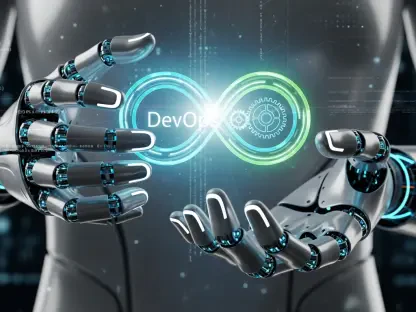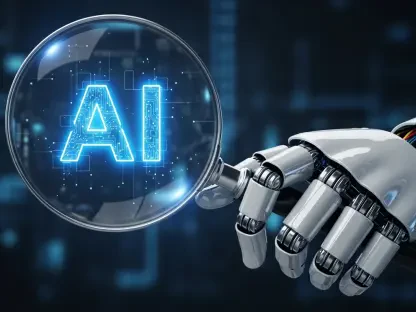Navigating the New Landscape: Why AI Changes Everything for Developers
Imagine a world where lines of code are generated in mere seconds, far outpacing even the most seasoned programmer, and this is no longer a distant vision but the reality of software development today, driven by artificial intelligence tools like Replit and GitHub Copilot. These platforms are automating mundane and repetitive coding tasks, fundamentally altering the traditional role of developers. The shift raises a critical question: how can human programmers remain indispensable in an era where machines seem to do it all? This guide aims to equip developers with strategies to adapt and excel amidst this technological transformation.
The impact of AI on coding is profound, as it not only accelerates development cycles but also challenges the very skills that once defined a programmer’s expertise. While AI handles routine work with unmatched speed, it lacks the nuanced understanding and creative insight that humans bring to the table. Developers must now pivot toward areas where their unique abilities—such as strategic thinking and innovation—shine brightest. This is not merely about keeping up but about redefining relevance in a rapidly evolving field.
This guide offers a clear roadmap through four essential survival tips tailored for developers navigating the AI era. These strategies focus on mastering AI tools, harnessing creativity, envisioning future trends, and sharpening analytical prowess. By embracing these approaches, programmers can secure their place in an industry increasingly shaped by intelligent automation, ensuring they thrive rather than merely survive.
The Rise of AI in Coding: Opportunities and Challenges
The integration of AI into software development marks a significant milestone in the history of technology. Over recent years, AI coding agents have emerged as powerful allies, capable of producing code at a pace and cost-efficiency that no human can match. These tools excel at automating repetitive tasks—think debugging standard errors or generating boilerplate code—freeing up time for more complex challenges. Their ability to operate without breaks or personal demands further amplifies their appeal in fast-paced development environments.
However, this efficiency comes with notable limitations that developers must recognize. AI systems, while adept at following patterns from existing data, struggle with tasks requiring genuine creativity or the invention of entirely new paradigms. For instance, designing a groundbreaking framework or solving a problem with no prior precedent remains firmly in the human domain. This gap highlights an opportunity for programmers to focus on innovation where machines fall short.
Moreover, AI tools are not autonomous; they require careful human oversight to ensure accuracy and relevance. Much like guiding a junior team member, developers must review and refine AI-generated outputs, providing context and strategic direction. This dynamic underscores the enduring importance of human expertise in steering projects toward success, balancing the benefits of automation with the need for thoughtful intervention.
Mastering the AI ErFour Essential Survival Tips for Developers
Adapting to the AI-driven coding landscape demands a shift in mindset and skill set for developers. The following four tips provide actionable strategies to maintain a competitive edge. Each focuses on an area where human strengths remain unparalleled, ensuring programmers can complement AI rather than compete with it.
Tip 1: Excel in AI Tool Mastery and Strategic Decision-Making
Becoming proficient with AI coding tools is a cornerstone for success in this new era. Developers must learn to interact with platforms like GitHub Copilot by crafting precise inputs that maximize output quality. Beyond technical proficiency, strategic decision-making—such as selecting the right programming language or framework for a project—remains a critical human responsibility. These choices shape the foundation of any software, and no algorithm can fully account for the nuanced trade-offs involved.
Crafting Precision Prompts for Maximum AI Efficiency
The art of writing effective prompts is essential when working with AI tools. Clear, specific instructions ensure that the generated code aligns with project goals, minimizing the need for extensive revisions. For example, instead of vague requests, providing detailed context about functionality or constraints can significantly improve results. Developers who refine this skill will find AI to be a powerful ally rather than a source of frustration.
Owning Critical Choices in Tech Stack Selection
Deciding on a tech stack is a domain where human judgment prevails. Factors like scalability, team expertise, and long-term maintenance often influence these decisions, requiring insight that AI cannot replicate. Developers must weigh these elements carefully, ensuring that choices align with both immediate needs and future growth. This strategic ownership sets the trajectory for successful software outcomes.
Tip 2: Unleash Creativity in Software Solutions and Architecture
Creativity stands as a bastion of human advantage in an AI-dominated field. While machines can replicate known solutions, they cannot imagine novel approaches or architectures without precedent. Developers must tap into their imaginative potential to design systems that break new ground, offering solutions that AI could never predict or produce on its own.
Drawing Inspiration from Diverse Experiences
Stepping outside the realm of coding can ignite fresh ideas for software development. Engaging in activities like painting, writing, or even cooking fosters a mindset of experimentation and originality. These pursuits encourage lateral thinking, enabling developers to connect seemingly unrelated concepts into innovative software designs that stand out in a crowded market.
Designing Unique Systems Beyond AI Patterns
The ability to craft unique system architectures is a skill that sets human developers apart. Combining disparate ideas into cohesive, groundbreaking designs—much like inventing a tool no one thought possible—requires a depth of vision AI lacks. Programmers who focus on pioneering such systems will create value that transcends the limitations of automated pattern recognition.
Tip 3: Adopt a Visionary Perspective on Technology Trends
Looking beyond daily coding tasks to envision the broader technological horizon is vital for staying ahead. Developers must cultivate a forward-thinking approach, focusing on how systems and trends will evolve over time. This perspective shifts the role from mere coder to architect of future-ready solutions, a space where human foresight excels.
Focusing on Big-Picture Architectural Design
Large-scale system planning offers an arena where developers can make a lasting impact. Prioritizing the overarching structure of software—how components interact and scale—over line-by-line coding allows for meaningful contributions. This high-level focus ensures that projects are built with resilience and adaptability in mind, addressing needs that AI cannot anticipate.
Anticipating Unmet Needs in Tech Evolution
Identifying gaps in the current tech landscape positions developers as innovators. By studying emerging patterns and predicting challenges, programmers can design solutions for problems yet to surface. This proactive stance not only adds value to their work but also establishes them as thought leaders in an industry driven by constant change.
Tip 4: Sharpen Analytical Skills to Create New Knowledge
Advanced analytical thinking is a powerful tool for developers aiming to differentiate themselves. The ability to synthesize information from diverse sources and produce original insights is a uniquely human trait. Honing this skill enables programmers to tackle complex challenges and contribute knowledge that AI, bound by existing data, cannot generate.
Developing Ph.D.-Level Problem-Solving
Elevating problem-solving capabilities to an expert level is crucial for addressing unprecedented issues. This involves breaking down intricate problems into manageable parts, questioning assumptions, and exploring unconventional solutions. Developers who commit to this depth of analysis will find themselves equipped to handle the most daunting technical puzzles.
Contributing Unique Value Through Original Insights
Creating new knowledge through analytical rigor sets developers apart from automated systems. Whether it’s devising a novel algorithm or uncovering a hidden efficiency, these contributions add irreplaceable value. Programmers who focus on generating such insights ensure their work remains relevant, pushing the boundaries of what technology can achieve.
Quick Recap: Key Takeaways for Thriving with AI
For developers seeking to navigate the AI era, the following points distill the essence of the strategies discussed:
- Master AI tools and make strategic decisions on tech stacks.
- Leverage creativity to design innovative software solutions.
- Think broadly about future trends and architectural planning.
- Hone analytical skills to produce original, impactful knowledge.
Beyond Survival: The Future of Developers in an AI-Driven World
The strategies outlined align with broader industry shifts, where AI and human programmers are increasingly seen as complementary forces. As AI continues to evolve, its capabilities will likely expand, taking on more sophisticated tasks. Yet, the demand for human innovation, particularly in imagining what’s next, remains a constant driver of progress in technology.
Looking ahead, developers may face challenges in maintaining relevance as automation encroaches on more domains. However, the focus on creativity, strategic vision, and analytical depth offers a buffer against obsolescence. These human-centric skills ensure that programmers can adapt to new tools and paradigms, shaping rather than reacting to change.
The coexistence of AI and human expertise also points to a collaborative future. Developers who position themselves as overseers of AI outputs, innovators of novel ideas, and architects of complex systems will find ample opportunities. This synergy promises a dynamic landscape where technology and human ingenuity fuel each other’s growth.
Final Thoughts: Embrace the AI Era with Confidence
Reflecting on the journey through these survival strategies, it becomes evident that adaptation is the cornerstone of success for developers in an AI-driven world. The focus on mastering tools, unleashing creativity, envisioning future trends, and sharpening analytical skills provides a robust framework for navigating this transformative era. Each tip carves out a space where human strengths outshine automation, ensuring relevance in a rapidly changing field.
Moving forward, developers are encouraged to take tangible steps by integrating these approaches into their daily practices. Experimenting with AI prompts, seeking inspiration from diverse fields, and dedicating time to strategic planning are actionable ways to start. These efforts promise to build resilience against technological shifts, securing a pivotal role in shaping the future.
As the landscape continues to evolve, staying proactive emerges as the ultimate key. Developers who embrace continuous learning and remain open to redefining their roles will find themselves not just surviving but leading innovation. The path ahead, though challenging, offers immense potential for those ready to harness both AI and human potential in tandem.









